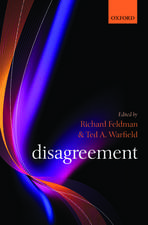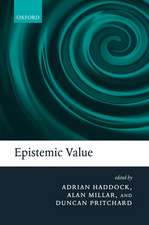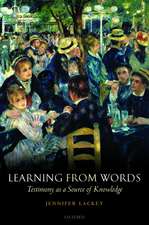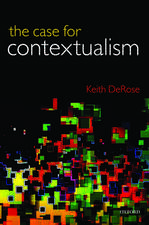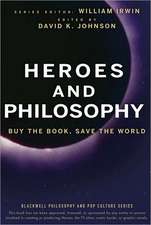Jacob Sigismund Beck’s Standpunctslehre and the Kantian Thing-in-itself Debate: The Relation Between a Representation and its Object: Studies in German Idealism, cartea 16
Autor Lior Nitzanen Limba Engleză Hardback – 11 iul 2014
Author Lior Nitzan reconstructs, step by step, the historical development of Beck’s doctrine. He shows how Beck's unique view is drastically different from that of his contemporaries and presents the relevance of Beck to contemporary debates about the proper interpretation of Kant’s notion of objectivity, the refutation of idealism and the role of the thing in itself in Kant’s transcendental idealism. In doing so, Nitzan presents a defense of Beck's radical perspective of Kant’s theory and claims that some of Kant’s negative responses to it may in fact be due more to the adversary academic environment at the time than to Kant’s true, well considered, opinion.
Jacob Sigismund Beck’s Standpunctslehre challenges the two dominant schools in the interpretation of Kant’s transcendental idealism—the "two world" and the "two aspect" view. It presents a new way of understanding Kant’s transcendental idealism, according to which the thing in itself plays no positive role in relation to the possibility of experience. Moreover, it claims that eliminating the thing in itself as the ultimate object of knowledge is not to admit idealism but in fact is the only way to consistently uphold realism. In addition, the book also addresses the question why, assuming that the proposed interpretation is correct, Kant had chosen not to make his true intentions clear.
| Toate formatele și edițiile | Preț | Express |
|---|---|---|
| Paperback (1) | 635.23 lei 6-8 săpt. | |
| Springer International Publishing – 3 sep 2016 | 635.23 lei 6-8 săpt. | |
| Hardback (1) | 641.51 lei 6-8 săpt. | |
| Springer International Publishing – 11 iul 2014 | 641.51 lei 6-8 săpt. |
Din seria Studies in German Idealism
-
 Preț: 400.37 lei
Preț: 400.37 lei - 18%
 Preț: 1804.49 lei
Preț: 1804.49 lei - 18%
 Preț: 775.90 lei
Preț: 775.90 lei - 15%
 Preț: 628.14 lei
Preț: 628.14 lei - 19%
 Preț: 542.48 lei
Preț: 542.48 lei - 18%
 Preț: 933.09 lei
Preț: 933.09 lei - 18%
 Preț: 716.02 lei
Preț: 716.02 lei - 15%
 Preț: 635.73 lei
Preț: 635.73 lei -
 Preț: 381.27 lei
Preț: 381.27 lei - 18%
 Preț: 778.84 lei
Preț: 778.84 lei - 24%
 Preț: 796.83 lei
Preț: 796.83 lei - 18%
 Preț: 773.59 lei
Preț: 773.59 lei - 15%
 Preț: 632.17 lei
Preț: 632.17 lei - 18%
 Preț: 778.05 lei
Preț: 778.05 lei - 15%
 Preț: 632.01 lei
Preț: 632.01 lei - 18%
 Preț: 935.24 lei
Preț: 935.24 lei - 18%
 Preț: 1210.68 lei
Preț: 1210.68 lei - 18%
 Preț: 939.14 lei
Preț: 939.14 lei - 15%
 Preț: 636.05 lei
Preț: 636.05 lei - 18%
 Preț: 941.47 lei
Preț: 941.47 lei - 18%
 Preț: 1097.73 lei
Preț: 1097.73 lei
Preț: 641.51 lei
Preț vechi: 754.72 lei
-15% Nou
Puncte Express: 962
Preț estimativ în valută:
122.81€ • 127.66$ • 101.82£
122.81€ • 127.66$ • 101.82£
Carte tipărită la comandă
Livrare economică 07-21 februarie 25
Preluare comenzi: 021 569.72.76
Specificații
ISBN-13: 9783319059839
ISBN-10: 3319059831
Pagini: 412
Ilustrații: XIII, 398 p. 1 illus.
Dimensiuni: 155 x 235 x 28 mm
Greutate: 0.75 kg
Ediția:2014
Editura: Springer International Publishing
Colecția Springer
Seria Studies in German Idealism
Locul publicării:Cham, Switzerland
ISBN-10: 3319059831
Pagini: 412
Ilustrații: XIII, 398 p. 1 illus.
Dimensiuni: 155 x 235 x 28 mm
Greutate: 0.75 kg
Ediția:2014
Editura: Springer International Publishing
Colecția Springer
Seria Studies in German Idealism
Locul publicării:Cham, Switzerland
Public țintă
ResearchCuprins
Part I.- 1.Introduction.- Part II - Kant's transcendental idealism and the notion of the thing-in-itself.- 2. The subjective conditions of objectivity.- 3. The seemingly inevitable roles of the thing-in-itself.- Part III - Jacob Sigismund Beck's Standpunctslehre.- 4. The development of Beck’s thought, leading up to the publication of the einzig möglicher Standpunct.- 5. The problem of the bond between a representation and its object.- 6. The requisiteness of resolving the problem of the bond between a representation and its object, for making intelligible the critique’s main concepts and distinctions.- 7. The highest principle of philosophy – the postulate to represent originally.- 8. Original representing and the categories.- 9. Synthetic and analytic unity of consciousness.- 10. Original representing and practical philosophy.- Part IV - Beck's Standpunctslehre in relation to Kant's original doctrine.- 11. The relation between sensibility and the understanding.- 12. The relation between a representation and its object.- 13. The thing-in-itself and practical philosophy.- Part V.- 14. Epilogue.- A short biography of J. S. Beck.- Index.
Notă biografică
The author has obtained a Bachelor degree in Law (LL.B) from the College of Management in Tel-Aviv, Israel in 1998 and a PhD in Philosophy from the University of Haifa, Israel, in 2012. He received the Rotenstreich Fellowship for exceptional Doctoral students. With the support of the Minerva Fellowship, the author has been a guest of the Department of Philosophy at the Humboldt University in Berlin between 2010-2011. He published several articles relating to the interpretation of Kant’s Transcendental Idealism and is currently working on the Neo-Kantian debate in Germany during the 19th century between psychologism and normativism.
Textul de pe ultima copertă
This book examines the unique views of philosopher Jacob Sigismund Beck, a student of Immanuel Kant who devoted himself to an exploration of his teacher's doctrine and to showing that Kant’s transcendental idealism is, contra to the common view, both internally consistent and is not a form of subjective idealism. In his attempt to explain away certain apparent contradictions found in Kant's system, Beck put forward a new reading of Kant’s critical theory, a view, which came to be known as the Standpunctslehre, the Doctrine of the Standpoint.
Author Lior Nitzan reconstructs, step by step, the historical development of Beck’s doctrine. He shows how Beck's unique view is drastically different from that of his contemporaries and presents the relevance of Beck to contemporary debates about the proper interpretation of Kant’s notion of objectivity, the refutation of idealism and the role of the thing in itself in Kant’s transcendental idealism. In doing so, Nitzan presents a defense of Beck's radical perspective of Kant’s theory and claims that some of Kant’s negative responses to it may in fact be due more to the adversary academic environment at the time than to Kant’s true, well considered, opinion.
Jacob Sigismund Beck’s Standpunctslehre challenges the two dominant schools in the interpretation of Kant’s transcendental idealism—the "two world" and the "two aspect" view. It presents a new way of understanding Kant’s transcendental idealism, according to which the thing in itself plays no positive role in relation to the possibility of experience. Moreover, it claims that eliminating the thing in itself as the ultimate object of knowledge is not to admit idealism but in fact is the only way to consistentlyuphold realism. In addition, the book also addresses the question why, assuming that the proposed interpretation is correct, Kant had chosen not to make his true intentions clear.
Author Lior Nitzan reconstructs, step by step, the historical development of Beck’s doctrine. He shows how Beck's unique view is drastically different from that of his contemporaries and presents the relevance of Beck to contemporary debates about the proper interpretation of Kant’s notion of objectivity, the refutation of idealism and the role of the thing in itself in Kant’s transcendental idealism. In doing so, Nitzan presents a defense of Beck's radical perspective of Kant’s theory and claims that some of Kant’s negative responses to it may in fact be due more to the adversary academic environment at the time than to Kant’s true, well considered, opinion.
Jacob Sigismund Beck’s Standpunctslehre challenges the two dominant schools in the interpretation of Kant’s transcendental idealism—the "two world" and the "two aspect" view. It presents a new way of understanding Kant’s transcendental idealism, according to which the thing in itself plays no positive role in relation to the possibility of experience. Moreover, it claims that eliminating the thing in itself as the ultimate object of knowledge is not to admit idealism but in fact is the only way to consistentlyuphold realism. In addition, the book also addresses the question why, assuming that the proposed interpretation is correct, Kant had chosen not to make his true intentions clear.
Caracteristici
Presents a radically new way of understanding Kant’s transcendental idealism Reconstructs, step by step, the historical development of Beck’s Doctrine of the Standpoint and contrasts Beck's views with those of his two major contemporaries – K. L. Reinhold and J. G. Fichte Defends the uniqueness of Beck's view and claims that it may actually represent Kant’s own intentions, which, in the author's opinion, was and still is widely misunderstood Includes supplementary material: sn.pub/extras

